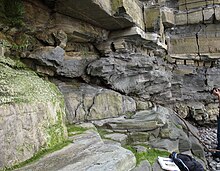
In structural geology, vergence refers to the direction of the overturned component of an asymmetric fold.[1] In simpler terms, vergence can be described as the horizontal direction in which the upper-component of rotation is directed.[2] Vergence can be observed and recorded in folds to help a geologist determine characteristics of larger fold areas.[1] Vergence is used to provide an overall characterization, in the symmetry (or asymmetry) of folds, and can be used to observe changes in small-scale structures in relation to the axis of a large fold.[3] The vergence of a fold lies parallel to the surrounding surfaces of a fold, so if these surrounding surfaces are not horizontal in nature, the vergence of the fold will be inclined. For a fold, the direction, as well as the extent to which vergence occurs, can be calculated from the strike and dip of the axial surfaces, along with that of the enveloping surfaces. These calculations can be very useful for geologists in determining the overall elements of larger areas.[1]
- ^ a b c Compton, Robert R. Geology in the field. New York. ISBN 0471829021. OCLC 11866897
- ^ Bell, A. M. (1981). "Vergence: an evaluation". Journal of Structural Geology. 3 (3): 197–202. doi:10.1016/0191-8141(81)90015-8
- ^ Marjoribanks, Roger W. (2010). Geological methods in mineral exploration and mining (2nd ed.). Berlin: Springer. ISBN 9783540743750. https://gatech.on.worldcat.org/oclc/654396234